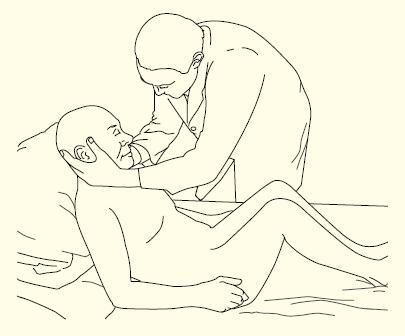Brudzinski’s sign
Editor-In-Chief: C. Michael Gibson, M.S., M.D. [1]
Brudzinski actually described several different signs in patients with meningitis. Brudzinski’s neck sign is most commonly recognized and is often simply referred to as Brudzinski’s sign.
With the patient supine, the physician places one hand behind the patient’s head and places the other hand on the patient’s chest. The physician then raises the patient’s head (with the hand behind the head) while the hand on the chest restrains the patient and prevents the patient from rising. Flexion of the patient’s lower extremities (hips and knees) constitutes a positive sign. [1] [2]
Brudzinski’s neck sign has more sensitivity than Kernig’s sign. [3]

References
- ↑ Brudzinski J: Ueber neue symptome von gehirnhautentizundung und reizung bei kindren, ins besondree bei tuberkulosen. Berliner Klinische Wochenschrift 1916;53: 686–690.
- ↑ Verghese A, Gallemore G: Kernig’s and Brudzinski’s signs revisited. Rev Infect Dis 1987;9:1187–1192.
- ↑ Brudzinski J: Un sign nouveau sur les membres inferieurs dans les meningitis chez les infants (sign de la nuque). Archives de la Medicine Enfant 1910; 12: 745–752.